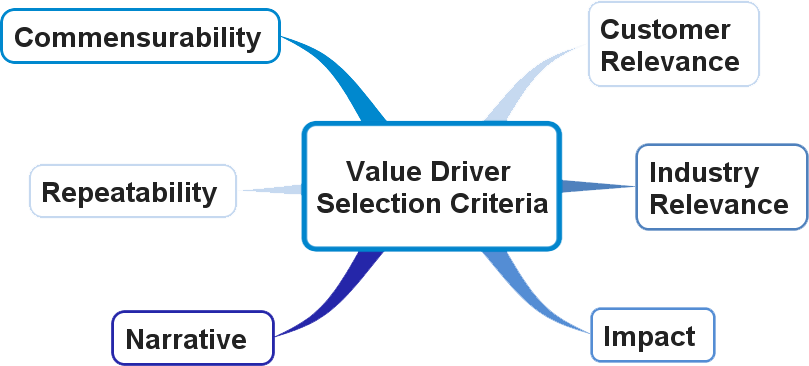Here is a very unique scenario. You are in the middle of building your value model for a new product or service and you realize you have a dozen potential drivers of positive differentiation you can choose from. This is great problem to have but it can create some issue with how to select the most appropriate value drivers for your value model.

- Commensurability: the first rule of a good value driver is that you have to be able to quantitatively measure its differentiation value. This is first and foremost! Value is a number and it is critical to be able to quantify the driver by using relevant data and mathematical formula. Any driver that is not measurable becomes a “nice-to-have” driver in the model.
- Relevance: Relevance to customers is equally essential. The value driver description and the proposed language have to strongly resonate with customers. A manufacturing company might be sensitive to yield improvement or capacity utilization. A service company might promote user efficiency or transaction productivity rate. Bottom line, a good discovery process will uncover the vocabulary and the drivers most frequently mentioned during customer interactions. Make sure you use the right customer language in the driver description as well as in the relevant value message.
- Impact: Once you can quantify the drivers and judge of their relevance, select the drivers with the great BANG power. These are the ones generating the highest differentiation value for customers. Remember that you can only select three to five drivers for a specific model. So the bang for the buck is important in order the eventually justify the premium you will eventually have in your pricing level.
- Narrative: Select drivers for which you can create and develop a powerful value story. The narrative using customer-relevant words and success stories can make the difference in a model. At the end of the day, you are selling a story and the way to create the narrative makes a huge difference. Some value drivers are plain vanilla ones. Can you spice up your model with something a bit unique and disruptive?
- Repeatability: Once you are able to quantitatively measure the differentiation value of a driver, can you repeat the measurement and have the same outcome over and over? Do you have robust and reliable measurement and test methods that deliver a consistent outcome? Repeatability brings credibility to the discussion especially when interacting with analytical customer departments i.e. quality, engineering, manufacturing and finance.
The selection of the most appropriate value drivers is an important process and one that has to be done collectively. You have the options to develop several value models for various stakeholders, various customer segments and various versions of your products and services. There is always a need to go through some sort of selection process. Select based on commensurability and relevance first. Remember you have to catch your customers’ attention after the first or second value driver during the value selling process!
Be bold. Join the value-based pricing revolution!
Stephan Liozu (www.stephanliozu.com) is the Founder of Value Innoruption Advisors and specializes in disruptive approaches in innovation, pricing and value management. He earned his PhD in Management from Case Western Reserve University and can be reached at sliozu@case.edu.

